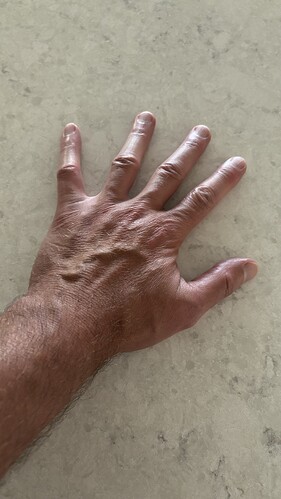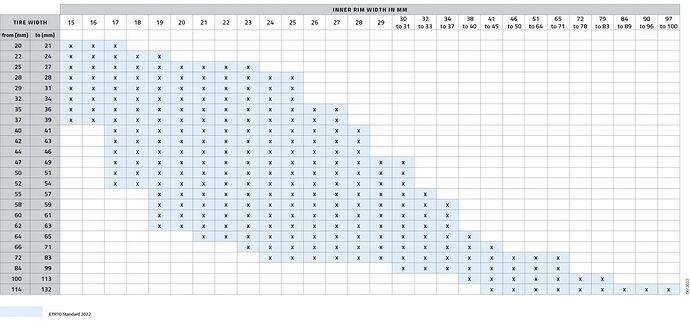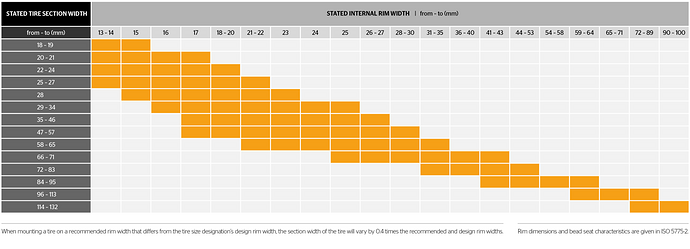YET the only real transition blow-out stories are about ill-seated latex tube setups…![]()
Funny, I didn’t expect the hands of a newly-retired Federal agent to look so, well, graceful.
Let’s just face the honest truth… hookless rims are just a problem in search of a problem.
I’ll just pop in here, for those who prefer the shackles of ‘non-Freedom’ units, that for Celsius and easy calculation is that the pressure will increase/decrease by 1 psi for every 3 degrees of temperature.
Quite possible in transition before 6am the tyre will be cool. The athlete needs to check the forecast to see what the air temperature will be before rolling out of T1 and note how directly in the sun the tyre(s) will be. Once rolling, the high convection losses will drop the tyre temperature to close to air temperature and reach a balance against hysteresis heat generation.
So if an athlete wants to roll at 70psi and the air temp is due to rise from 10C to 25C (mid ride air temperature) then they need to inflate to 65psi before heading for the swim start.
On the plus side every increased degree drops the Crr, we are told.
Edit: I have been ‘freely’ inconsistent. as @Yutaka_Sonik has observed.
In ‘non-Freedom’ units for degrees Celsius and kPa, the easy calculation is that the pressure will increase/decrease by 3 kPa for every 1 degree of temperature (C) change.
Isn’t it a big mess?
You forgot that psi are freedom units too?
Comment and then a question. I’d encourage people to listen to Josh’s full comments not just the click bait title. It’s only 10min and at the beginning
Question for you : he says that the min tire width is inner width+3mm for hooked and inner+5mm for hookless. Is this a standard or a recommendation ?
Just a fun anecdote that I thought would fit in; for several years I ran the Conti Supersonic 20mm tyres (with latex tubes) on HED Jet wheels that were 21mm inner width (hooked). They measured around 24.5 mm on those rims IIRC. I think I ran them around 80-90 psi (~5.5-6.2 bar). No blowouts, but several good results ![]()
AFAIK, those standards are based on ETRTO standards. Hence the microhooks on the new ENVE 4.5 Pro with a 24.5 inner to be able to run a 28mm tire, where a standard 4.5 (25mm TSS) requires at least a 30mm tire.
CO-sign on the “actually listen to what Josh said” comment. I’m sure he’d appreciate that, and it would save him at least a few unpleasant phone calls.
That’s a recommendation. ETRTO (as of 2024) guidelines don’t differentiate between hooked/hookless for these purposes. Here’s a compatibility chart based on the regs -
I’d be careful with that chart - that’s the 2022 version. The latest update (I believe 2023, certainly in the 2024/5 table I have in front of me) moves the minimum tyre size for a 24mm or 25mm internal rim width up to 29mm. Hence the introduction of a number of 29mm tyres (Vittoria & Conti are examples).
Interestingly, whilst ETRTO don’t differentiate between hooked & hookless rims, the internal rim width measurement (“A” on the drawings) is taken between the inner face of the hooks on a hooked rim, versus the inner face of the sidewall on a hookless rim.
To the poster above, the Enve 4.5 Pro model has a 23.5mm internal rim width, hence stated compatiblity with a 28mm tyre.
thanks for posting
Yeah, the latest chart moves things around at - at least - that overlap point between sizes on the old chart. Or so I have heard, but I don’t want to buy the new version.
Can you post a cap of the '25 chart?
TBH, this entire discussion is largely moot… Hookless [for road] is already a dead man walking.
If these bullets are true, then the pro tour wheel makers will need to make wheels compatible with 28mm tires.
- The new ETRTO chart does not support 28mm tires on 25mm internal rims.
- UCI requires that teams follow this ERTRO standard/recommendation (the actual word is irrelevant).
- Pro teams want to run 28mm tires.
- Pro teams want to run wider wheels with ~25mm internal width.
Enve is already making 25mm internal wheels that support 28mm tires. Presumably, the other pro tour wheel manufacturers (Campagnolo, Shimano, Vision, Swiss Side, Miche, Princeton CarbonWorks, Newman, Black, Bontrager, Zipp, Roval, Ursus, Cadex, Reserve, and DT Swiss) will follow if not already there, like Cadex and Princeton CarbonWorks. That list is a massive chunk of the industry. I think it is unlikely that they will continue making two classes of wheels: pro-tour compatible (hooked) and everyone else (hookless).
Hookless [for road wheels] is all but dead as the major wheel companies revert back to hooked or micro-hooked to be compatible with UCI rules and teams that want to run 28mm tires on wide rims.
It’s over.
ETRTO doesn’t differentiate between hookless and hooked. If your reasoning for why “hookless is dead” reduces to “you can use bigger tires on wider rims” it’s simply not currently supported by the regs.
Well… It might take a bit of digging to get the full context, and maybe it is just the measurement nuance that @dov_parcours pointed out above, that ENVE’s micro-hook gets an official 23.5mm measurement while still having a net wide profile. Maybe others will merely make narrower hookless that are compliant. But then those would be narrower overall compared to ENVE’s design and fail rule of 105. The hook is key to solving for best aero match while staying ERTO-compliant.
I think hookless [for road] is dead because of UCI’s rule to follow the ETRTO standard on tire versus wheel fitment.
No shade to YOU posting this, but for any hookless defenders, this is why it’s dumb. Folks discussing this here are among the nerdiest it gets (meaning this affectionately!), and we’re arguing about which chart of inner rim width vs tire size and the acceptable difference down to single millimeters is valid…
Stop, look yourself in the mirror, you know deep down. Smart, good tech doesn’t require this type of debate to figure out, or have such small margins of error for, critical details where lives/bodily injury hangs in the balance.
The fact that it largely works or most people have not had issues is a horseshit defense, not synonymous with there not being an underlying problem.
Again, just to be really nerdy, these restrictions don’t just apply to hookless rims.
Folks might feel like they have more margin for error with hooks, but “officially” - and in terms of UCI and ETRTO regs - they don’t.


